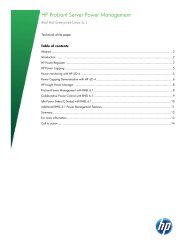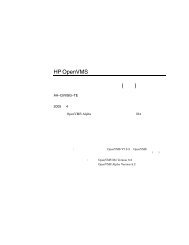HP ProCurve Wireless Access Point 420 - Hewlett Packard
HP ProCurve Wireless Access Point 420 - Hewlett Packard
HP ProCurve Wireless Access Point 420 - Hewlett Packard
Create successful ePaper yourself
Turn your PDF publications into a flip-book with our unique Google optimized e-Paper software.
Using the <strong>HP</strong> Web Browser Interface<br />
Status Reporting Features<br />
4-18<br />
AP System Configuration. The AP System Configuration table displays the<br />
basic system configuration settings:<br />
■ System Up Time: Length of time the access point has been up.<br />
■ MAC Address: The physical layer address for this device.<br />
■ System Name: Name assigned to this system.<br />
■ System Contact: Administrator responsible for the system.<br />
■ DHCP Status: Shows if IP configuration is via a DHCP server.<br />
■ IP Address: IP address of the management interface for this device.<br />
■ IP Default Gateway: IP address of the gateway router between this<br />
device and management stations that exist on other network segments.<br />
■ HTTP Server: Shows if management access via HTTP is enabled.<br />
■ HTTP Server Port: Shows the TCP port used by the HTTP interface.<br />
■ Version: Shows the version number for the runtime code.<br />
AP <strong>Wireless</strong> Configuration. The AP <strong>Wireless</strong> Configuration table displays<br />
the following wireless interface settings:<br />
■ SSID: The service set identifier that identifies this wireless group.<br />
■ Radio: Indicates if the access point is operating in 802.11b, 802.11g, or<br />
mixed (b &g) mode.<br />
■ Radio Status: Indicates if the access point radio is enabled or disabled.<br />
■ Auto Channel Select: Indicates if the access point automatically selects<br />
an unoccupied radio channel.<br />
■ Radio Channel: The radio channel through which the access point<br />
communicates with wireless clients.<br />
■ Radio Encryption: The key size used for data encryption.<br />
■ Radio Authentication Type: Shows if open system or shared key<br />
authentication is used.<br />
■ 802.1x: Shows if IEEE 802.1x access control for wireless clients is<br />
enabled.<br />
AP Ethernet Configuration. The AP Ethernet Configuration table displays<br />
the following ethernet interface settings:<br />
■ Subnet Mask: The mask that identifies the host address bits used for<br />
routing to specific subnets.<br />
■ Primary DNS: The IP address of the primary Domain Name Server on<br />
the network.<br />
■ Secondary DNS: The IP address of the secondary Domain Name Server<br />
on the network.

















